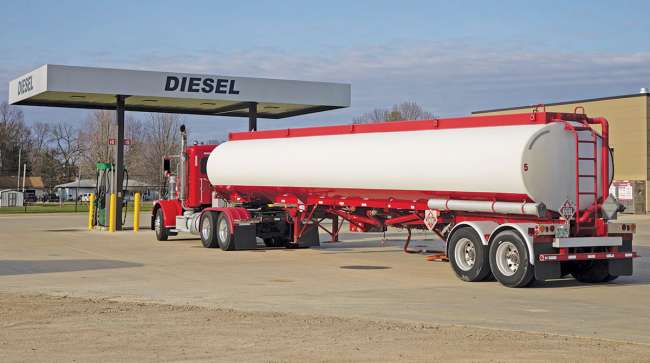Staff Reporter
Diesel Prices Eased in 2023 in Lone Bright Spot for Costs

[Stay on top of transportation news: Get TTNews in your inbox.]
Nationwide on-highway retail diesel prices ended 2023 some 14.5% below where they began the year, closing a 12-month stretch that was far less painful for fleets in terms of fuels costs than the prior year had been.
The nationwide average kicked off 2023 at $4.583 per gallon but had fallen to $3.914 per gallon by Christmas Day, the 15th time the weekly mean sat below $4 per gallon during the year, according to Energy Information Administration data. EIA issues retail diesel price data every Monday, except on holidays.
In 2022, carriers rode a much scarier roller coaster. That year, prices topped $5 per gallon from the middle of March through the start of August, as well as for much of that October and November, after beginning the year at $3.613 per gallon.
The decrease in prices on a year-on-year basis since the end of the first quarter of 2023 has been one of the few positives in the trucking space, American Trucking Associations Chief Economist Bob Costello told Transport Topics, noting that every other cost increased.

Costello
Diesel is usually the second-largest expense for trucking companies, said Costello. When prices are high, capacity is going to leave the industry, and as the diesel price decreases the rate of exits will decline, he said.
Prices in the first half of the year were not helpful to carriers, Eric Starks, chairman of the board at economic forecaster FTR Transportation Intelligence, told TT.
But the picture improved as the first half progressed, with diesel’s nationwide average falling in 20 of the first 23 weeks of 2023. The average U.S. retail price fell 9.5 cents in the week that ended Feb. 13, the largest week-on-week decline of 2023. A matching decline was seen in the week ending Oct. 9.

Starks
Before rates began falling, carriers were getting crimped by fuel prices, Starks said, adding that a strong diesel price is much more detrimental for spot markets and for owner-operators. In the second half of 2023, there was some relief on a cash flow basis, as well as to shippers on contract rates, he noted.
At the midpoint of the year, in the week that ended July 3, prices averaged $3.767 per gallon.
Regionally, the lowest prices at that point were on the Gulf Coast, home to nearly 50% of the country’s refining capacity, where the average cost for a gallon was $3.468.
The biggest price increase of the year for nationwide prices was a jump of 22.2 cents per gallon in the week that ended July 31. By August, the average price was above $4 per gallon again.
Over the next three months, the price of trucking’s main fuel regained all the ground lost in the first half of the year, starting October at a nationwide average of $4.593 per gallon.
ERoad's Craig Marris gives advice on carving out a practical, effective road map to a greener and more efficient fleet. Tune in above or by going to RoadSigns.ttnews.com.
“It was a bit of a seesaw year for diesel prices,” Costello said.
Prices in California, typically the most expensive place in the country to fuel up, first topped $6 per gallon in the week that ended Sept. 18, after jumping 22.2 cents compared with the previous week.
The average price in California topped $6 per gallon for seven weeks in September and October, the only time any region in the nation saw an average above that mark in 2023.
In contrast, only 14 weeks in 2022 did not see California post an average price above $6 per gallon. And prices at the pumps in the Central Atlantic and New England both joined the Golden State above $6 per gallon for the entirety of May 2022.
For almost all of the rest of the fourth quarter of 2023, prices across the country eased lower, with the average across the U.S. sitting at $3.914 per gallon on Christmas Day.
Still, prices are less volatile than observers would have expected with the conflicts going on around the world at the moment, Starks said.
Macroeconomic factors, such as wars in Ukraine and Gaza or unexpected changes in Chinese demand, are not having the same impact analysts would expect.

De Haan
In addition, the past 12 months were challenging in terms of demand, GasBuddy Head of Petroleum Analysis Patrick De Haan told TT, with the logistics sector hurt by inventory cuts.
U.S. freight volumes, as measured by the Cass Freight Index, have fallen for most of the past two years, similar to prior down cycles in both length and magnitude, except for the pandemic downturn, Cass Information Systems said.
“We have not seen a ‘freight recession’, rather a balancing out. It has been a ‘rate recession’, so fuel becomes a bigger factor,” Starks said.
Even peak shipping season disappointed. Peak season was decidedly soft in the for-hire market, as real retail sales remain weaker than year-ago levels, Cass Information Systems and ACT Research said.

Denoyer
General economic conditions remain better than those in the for-hire freight market, said ACT Senior Analyst Tim Denoyer.
While U.S. demand for diesel from the freight sector waned, wholesale and therefore retail prices found some support from certain fundamental factors, including weaker supply levels.
U.S. distillate output — mostly diesel alongside significantly less heating oil — fell 150,000 barrels per day year-on-year in 2023 to an average of 4.8 million barrels per day, according to Wood Mackenzie data.
Diesel production fell partly as a result of the yield from crude runs at refineries decreasing because jet demand rose 1 million barrels per day in 2023, said Alan Gelder, Wood Mackenzie vice president of refining, chemicals and oil markets.
Want more news? Listen to today's daily briefing above or go here for more info
In addition, there is a lighter crude slate available globally due to Saudi Arabia-led production cuts first announced in July, which leads to less diesel being produced.
A Saudi-led coalition of producers extended the length of the 1.3 million-barrels-per-day cut in September, and promised in late November to ramp up the reductions to 2.2 million barrels per day in the first quarter of 2024.
Still, refineries remained incentivized to produce diesel as opposed to gasoline.
According to Wood Mackenzie data, U.S. Gulf Coast diesel crack spreads averaged $28 per barrel above Louisiana Light Sweet (LLS) crude in 2023, compared with more than $17 per barrel above LLS for gasoline.
Refineries also are producing diesel in what has been a mild winter so far because the key cold months of the winter are still to come. The first polar vortex will have a significant impact on prices, De Haan said.
Distillate fuel production increased to 5.1 million barrels per day in the week that ended Dec. 1 from 5 million barrels per day a week earlier. According to EIA, it was only the 10th time output topped 5 million barrels a day in 2023.





